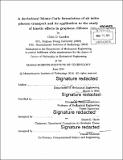A deviational Monte Carlo formulation of ab initio phonon transport and its application to the study of kinetic effects in graphene ribbons
Author(s)
Landon, Colin Donald
DownloadFull printable version (8.869Mb)
Other Contributors
Massachusetts Institute of Technology. Department of Mechanical Engineering.
Advisor
Nicolas G. Hadjiconstantinou.
Terms of use
Metadata
Show full item recordAbstract
We present a deviational Monte Carlo method for solving the Boltzmann equation for phonon transport subject to the linearized ab initio 3-phonon scattering operator. Phonon dispersion relations and transition rates are obtained from density functional theory calculations. The ab initio scattering operator replaces the commonly used relaxation-time approximation, which is known to neglect, among other things, coupling between out of equilibrium states. The latter is particularly important in two-dimensional materials such as graphene, which is the subject of this thesis. One important ingredient of the method presented here is an energy-conserving, stochastic particle algorithm for simulating the linearized form of the ab initio scattering operator. This scheme is incorporated within the recently developed deviational, energy-based formulation of the Boltzmann equation, to obtain, for the first time, low-variance Monte Carlo solutions of this model for time- and spatially-dependent problems. The deviational formulation ensures that simulations are computationally feasible for arbitrarily small temperature differences, while the stochastic treatment of the scattering operator is both efficient-in the limit of large number of states, it outperforms the more traditional direct evaluation methods used in solutions of the homogeneous Boltzmann equation-and exhibits no timestep error. We use the method to study heat transport in graphene ribbons, a geometry used to experimentally measure the thermal conductivity of graphene. Our results show that the effective thermal conductivity of ribbons decreases monotonically as either the length or the width of the ribbon decreases. We also show that at room temperature the error introduced by modeling the effect of transverse diffuse boundaries using a homogeneous scattering approximation is on the order of 10% and as high as 30%. A simple parametric model for the effective thermal conductivity depending only on the Knudsen number is presented that outperforms the homogenous scattering rate approximation in terms of accuracy. Spatially resolved temperature and heat flux profiles are also obtained and analyzed for the first time in graphene ribbons using the linearized ab initio scattering term.
Description
Thesis: Ph. D., Massachusetts Institute of Technology, Department of Mechanical Engineering, 2014. Cataloged from PDF version of thesis. Includes bibliographical references (pages 143-151).
Date issued
2014Department
Massachusetts Institute of Technology. Department of Mechanical EngineeringPublisher
Massachusetts Institute of Technology
Keywords
Mechanical Engineering.